Hamish Bowles
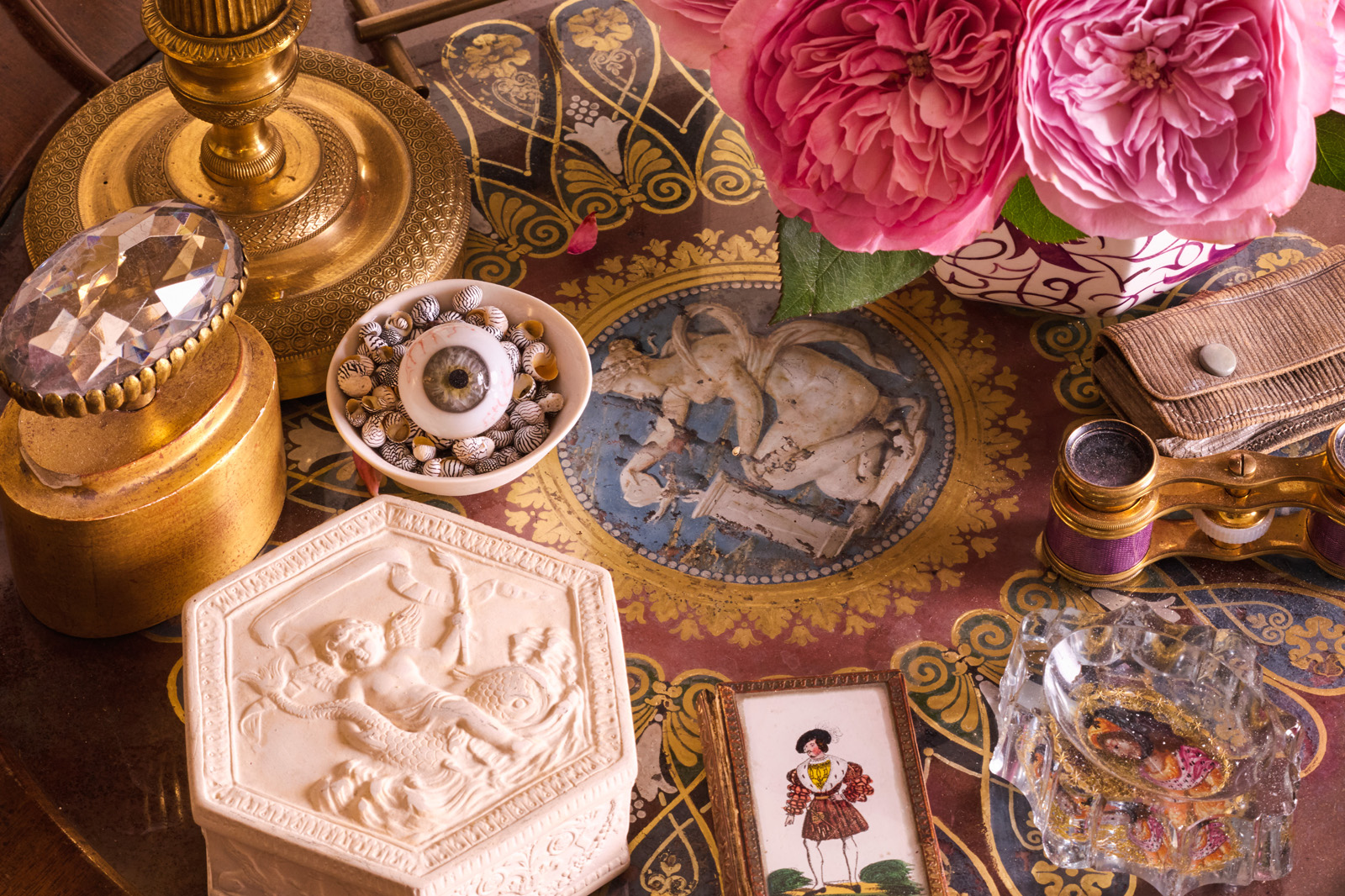
On the verre églomisé top of a Charles X table found in the Clignancourt flea market, gifts from friends include a paperweight from Albert Hadley, an early 19th-century terracotta box from Allegra Hicks, a surrealist eye from Allison Sarofim, and a Georgian salt from Gordon Watson.
Although nothing could be further from the cork-lined bedroom on the Boulevard Haussmann in Paris where Proust lay obsessively writing his masterpiece, Hamish Bowles’s apartment near University Place in New York is as evocative of past time as any dipped madeleine. There might well be a slippered Céleste figure in the background, straightening Master Hamish’s monogrammed slippers, folding that cerise dressing gown and placing the little vase of muguet on his bedside bureau – rather than the reality of his yet again packing a suitcase (an aesthetic education in itself, never mind its bonsai-compression aspects) for another foray into the teeming international world in which he lives.
So who is Hamish and what is he, that all his friends commend him? He is atavistic, modern, isolated, sociable, a scholar, a dandy, an aesthete, an obsessive collector, a balletomane, a writer, a curator, a darling of fashion. He has been a peripatetic International Editor at Large on American Vogue for over twenty years. He is much loved by a great many people, gossiped about, speculated on, knows everyone and everyone claims to know him. (Gentle reader, you know what I mean by everyone.) Where he lives is at the center of his life. Everything in it matters. Every vision. Every detail. Every flounce. Every color, especially purple and lavender, although his prose – he writes beautifully – eschews the color (I can’t). Here are some of the things written or said about him and/or his apartment: “Eclectic but classical in feeing . . . Quirky neoclassicism . . . Fastidious taste . . . A certain amount of disdain . . . A breadth of culture.”
He was born and raised in England but there has never been anyone more suited to being called a citizen of the world than Hamish. “When I was a little boy my mum was obsessed with junk and antiques and I used to go with her and buy what I could afford with my pocket money. I was a solitary child, a funny mixture, and I had my own world entirely unrelated to the things my fellow schoolboys were interested in.” (I’ll say! He painted his boyhood bedroom a blushing-apple pink and hung reproduction Mucha posters and fabulous 1920s Vogue covers on the walls.) “So I was a real fish out of water, and my friends’ mothers thought I was a pernicious influence. I retreated into my own world and began collecting vintage fashion and haute couture. Christie’s South Kensington had started their costume and textile sales – so I skipped class, failed my French but acquired some marvellous things. I’ve just gone on collecting. I have three thousand pieces in storage now. It’s like an autobiographical collection.”
Frustrated at school, he took matters into those fine-grained hands of his and secretly put together a portfolio of his fashion drawings for St Martin’s School of Art. He was accepted, was soon noticed by the editors of fashion bibles and began working at Harper’s Bazaar. “Then Anna Wintour called for an interview for British Vogue and off I went in a Chanel jacket with a Chanel handbag insouciantly flung over the shoulder – that’s what I happened to be wearing at the time. I shudder to recall. Needless to say, I didn’t get the job.”

Studio Peregalli designed the gessoed library panelling and the green and gold paper frieze. The 18th-century mirror is flanked with pictures by (left) Martin Battersby, Philippe Jullian and Violet, Duchess of Rutland, and (right) Lawrence Mynott, Marcel Vertès and Pierre Le-Tan.
He is wonderfully funny and self-deprecating. When he recently visited a fanciful little palazzo in Sicily, he “just about fainted clean away in each new room.”
I could easily have a fainting fit or, in an archetypally Hamish phrase, je die when I enter his apartment, which lies like a tiny Atlantis in a 1920s building in Greenwich Village. Lo, sesame! Through a door tucked into a far first floor corner, one is transported into a magical domain, each room illuminating Hamish’s meticulous, obsessive attention to the cut and construction of his life. You dive into purple in a lobby hung in a buddleia-mauve moiré fabric he found made up in jackets at Atlas Silks in the Cairene souk. He sought out the source –as any halfway normal person might – at Alef in Zamalek, as it happens, but boldly went where no man had gone before and bought the entire stock. It now covers the walls as well as his body, walls crowded with close-hung prints and drawings, above a Louis XV chair upholstered by Albert Hadley in leopard-patterned pony skin and two Queen Anne Revival chairs designed by Frances Elkins – that great 1930s decorator – flanking a William IV console. (Those chairs were the first things Hamish bought after he moved to New York.)
This little charmer leads into a gessoed book-lined library/drawing room that looks like the manifest of a dream, resonating with a rich dialogue of color and harmony hovering between lilac and the appropriate favorite imperial purple. It reminds me of the Camondo Museum in Paris and is a conceit of visual nostalgia, but not an incarnation of the past. It is the result of a collaboration between Hamish and the Milanese architecture and design firm Studio Peregalli, ruled by two wizards, Roberto Peregalli and Laura Sartori Rimini.
So how to sum up Studio Peregalli? For my money – and my! you need a lot – they are the best decorators in the world, the sole inheritors of the mantle of Renzo Mongiardino, perhaps the greatest of modern baroque decorators. When Roberto and Laura met he was studying philosophy and the decorative arts and she was an architect fascinated by old buildings.
Roberto’s parents were friends of Mongiardino, so he was steeped in his ethos and aesthetic. The designers see his legacy as much more than an agglomeration of brilliant details. “He taught us to mix rigor with imagination,” Peregalli says. Mongiardino’s nostalgic rooms and romantic stage sets are mapped into their collective unconscious. (The first time I saw an example of his work was in Lee Radziwill’s house near Oxford, decades ago; I was bowled over.) Studio Peregalli’s superb artists and craftsmen bring their coup d’œil magic to palazzos and mini-palazzos all over the world. (Nothing as prosaic as the word house or apartment can contain their style; that witty cynosure Patrick Kinmonth – who once pronounced, succinctly and accurately, that decoration is a matter of biography – even coined the word “flatazzo” to describe Hamish’s apartment.)
Seeing these rooms also reminds me on a miniature scale of Charles de Beistegui’s extravagant Château de Groussay (fabulous is not too strong a word). Beistegui had been a fanatical modernist in the 1920s but he turned against the movement and proclaimed that minimalism was bourgeois. And indeed Hamish’s apartment shows up the modernist, minimalist, boring, tame sameness of so many New York apartments. Hardly anything fashioned after the First World War has made the cut. The place is padded and chintzed and painted and carved and stuffed with gilt and garniture and Louis XV furniture up to its pretty eyes. But his style has style – he knows how to play things right up and then to prick any pomposity by playing it right down. For example: a huge unicorn head rears in the broken pediment in his drawing room/library. “I found it in Oyster Bay on Long Island. I always loved unicorns and I love how it deflates the pomposity of the broken pediment.”
Every room is crowded with the culmination of his discerning years of collecting, including objets de vertu, objets trouvés, books, drawings, pictures and recherché Louis XV and Louis XVI furniture which is, as he says, “bafflingly unfashionable.” I shouldn’t think it will be for much longer. (Oscar de La Renta gave him the moss-colored silk velvet that now upholsters a Louis XVI bergère stamped Jacob.)
It is a romantic interior in the true sense – defined not only as a stylistic term but also by the character of the objects it contains and by the motives of its creators. His motives include creating a Hamish cosmology. In his drawing room and in his dressing room are portraits of himself taken or painted by friends over the last thirty years . . . “and a proper rogue’s gallery it is.”
It could all give a minimalist a panic attack, but it shows the knowledge, taste and relish of a cultivated and refined man. It’s an apartment you can imagine the Comte de Mornay, or Cecil Beaton, or Madeleine Castaing finding ravishing. He discovered it seven years ago. “I was living in Sutton Place, which was perfect when I was working on the Jacqueline Kennedy show.” (He curated “Jacqueline Kennedy: The White House Years” at the Metropolitan Museum of Art in 2001.) “But afterwards it felt a bit distant from things and I thought to move. Friends who had been house-hunting called to tell me of this apartment in a building I sort of knew about – it has attracted aesthetes through the years and was built for bachelor artists. A kitchen in the basement served the whole building – a dumb waiter threaded its way up through all the apartments. I have to say my heart skipped a beat when I saw it – it was the apartment of my dreams – talk about pomegranate possibilities!
“It belonged to a literary editor who had lived there for more than fifty years from 1957, and it was in an advanced state of decrepitude; she had not touched it for years. Festoons of wires looped everywhere and layers and layers of old greying net curtains. Sagging bookcases lined the walls and I found a window completely blocked by bookshelves. There was a quaint Sunset Boulevard-ish wrought iron Juliet balcony opening into the main room. In a way it had a kind of appealing dowdiness and I had a plan in the works . . . there was going to be minimal architectural intervention . . . Fâcheuse illusion!” His voice trails away. “Then Studio Peregalli arrived. I had known Roberto and Laura for years – but to employ them you have to be Maecenas. So when they said, ‘What about us doing it as our American calling card . . .’” Hamish and I stare at each other open-mouthed. He nods. I say, channelling Shylock: “Thus ornament is but the guilèd shore to a most dangerous sea.”
“I know!” He nods. “So I was overjoyed and amazed but also quaking in my boots. I’ve never ceded my taste to anyone and I knew they were ruthless. After twenty minutes looking around the apartment and the endless immensity of books Roberto said, ‘You need a library drawing room’ and sketched the proverbial back-of-an-envelope scheme: incredibly, it was much as it is now.
“I went to where the preliminary work is done in Milan – a Renaissance barn in a dowdy part of town and they had constructed the room so I could see the scale and make adjustments – I felt like Marella Agnelli.
“I get so exasperated by the perfection of their eye! Look at the mirror over the mantel.” We look at its eighteenth-century English giltwood precarious Pisa-ing perfection. “They were at Christie’s in the Rockefeller Center in New York and spotted it. I couldn’t envisage it. They said, ‘You just angle it like you do in palazzi.’” Below it on the mantelshelf stands a magnificent gilded clock featuring Achilles admiring his heel, much good it did him. Hamish found it in the Clignancourt flea market, and fell on it with stifled cries of delight. He points up at the tole and glass chandelier. “It’s from Parma – they were made in the nineteenth century to be used for one-night illuminations only – pop-up chandeliers for marquees! We hung it with some trepidation.” Of course, it works like a dream.
“Then they showed me a seventeenth-century Oushak medallion carpet. I said, ‘It’s so dark and looks so dreary,’ but they said no, you need it to bring it all together. It transformed the room beyond all imagining.” The pedimented bookcases are gessoed and have a finely painted bitter lemon line just inside their shelves. “I had a David Hicks obelisk in storage from ages ago and it has the exact same line of bitter yellow inside!”
Above the broken pediment is an exuberant hand-painted mossy damask frieze by Edvige Tamburini (“the poet of the paintbrush,” says Hamish), who also hand-painted the fine stripes for his dining room in her garage in Bologna. In New York she gessoed the woodwork, shadowed the ceiling molding, faked some cornices, painted the entrance hall a pale ochre marble, and by nifty brushwork turned the little staircase which leads to his private rooms (“a wisteria cradle”) into dark mahogany magnificence, an effect helped by the newly created Palladian arch at the staircase entrance. Above the pediments a fraction of his esoteric collection of prints and paintings hangs below the dramatic and ornamental ceiling.
That little balcony he had a softness for has now been transformed into a pair of grand, partially false double doors, which make his apartment seem much larger. Amplifying available space is one of Studio Peregalli’s crafty skills.
He tells a story about working with them that illustrates – literally – their zeal and commitment. He found two lamps in a Paris flea market which were shipped to Milan for lampshades. When he unpacked the crate back in New York, he found the two working sketches for his lamps. “They looked as though Piranesi had done them. You could have framed them.”
The 1930s Lucite chandelier in his bedroom remains a bone of contention with his mentors. There is no doubt it has to go; amusement has it place, but not on his bedroom ceiling. It is a delightful and evocative room, with the bed in the middle of a maze of books, but it’s not a room everyone could sleep in. For a start, visually there is so much to keep you awake and wondering. The walls are covered in 1880s lilac sprig document chintz, and a corona reigns over a Syrie Maugham designed sleigh bed upholstered in a Madeleine Castaing stripe, with a patchwork quilt found in Westbourne Grove in London. And could that really be Truman Capote over there in that pencil drawing?
“It’s the most extraordinary thing,” Hamish says. “When I first came to New York – and it was a bit overwhelming to say the least – I moved into the parlor floor in a brownstone on the Lower East side.” His possessions consisted of a mattress, two chairs, a bedside table and a pencil drawing by René Bouché of Truman Capote, his head propped on his hand, that he had just bought in the attic sale of Capote’s estate. “I couldn’t afford it but I bought it as a good luck for my life in New York. I hung it up on a random nail in the wall. My ancient landlady came in to pick up the rent and looked startled. ‘That’s very odd,’ she said, looking at the drawing. “I didn’t think Jack had left that behind.” It transpired that Jack Dunphy, Capote’s long-time lover, had lived in the apartment and had hung the picture in the very same place.
This story contains a multitude of the elements that go to fashion Hamish’s life (and fashion is the mot juste here), a life full of delightful, almost absurd, felicities and happy collisions. For the pretty dining room, for example, Robert and Laura designed a neoclassical scheme to disguise mismatched beams and step-backs with four doors with œil de boeuf windows and linked panelling, and then found, an original eighteenth-century version of exactly that, with far more elaborate panelling of ribbons, lilacs and roses, in a sale in France. They adapted it to fit, their restorer stripped it down to the original arsenic green and then they created a perfect duplicate for the opposite wall.
One of the funniest and nicest things in the apartment is the story behind the small door into the bathroom. To reach this room involves a serpentine, Ulysses-like voyage, maneuvering past wondrous islets of bureaus and ottoman and footstools, past inlets and peninsulas of books and objects and tables (one inlaid with lavender leather), past long cartons filled with a new consignment of delectable and precious couture clothes for his collection, which now includes pieces by Molyneux, Mainbocher, Lanvin, Jacques Fath, Balmain, Givenchy, Schiaparelli (“I am always excited by Schiaparelli”), Saint Laurent, Chanel, Poiret (“He was fired from Worth”), Vionnet, Paquin, Doucet, and Dior, and I am sure will one day be housed in the Hamish Bowles Couture Museum. You couldn’t swing a cat. But the local planning office (with, as Hamish describes it, “their blood-boilingly irrational dictates”) insisted that there should be wheelchair access, and to this end also insisted that the door into the bathroom (which is carved out of the old dumb waiter facility) be big enough to let the putative wheelchair through. The Peregalli/Bowles combo solved the problem by cutting a jib piece out of the wall so that door and part of the wall swing open in a coup d’œil. A microcosm of the dazzling place it lives in.
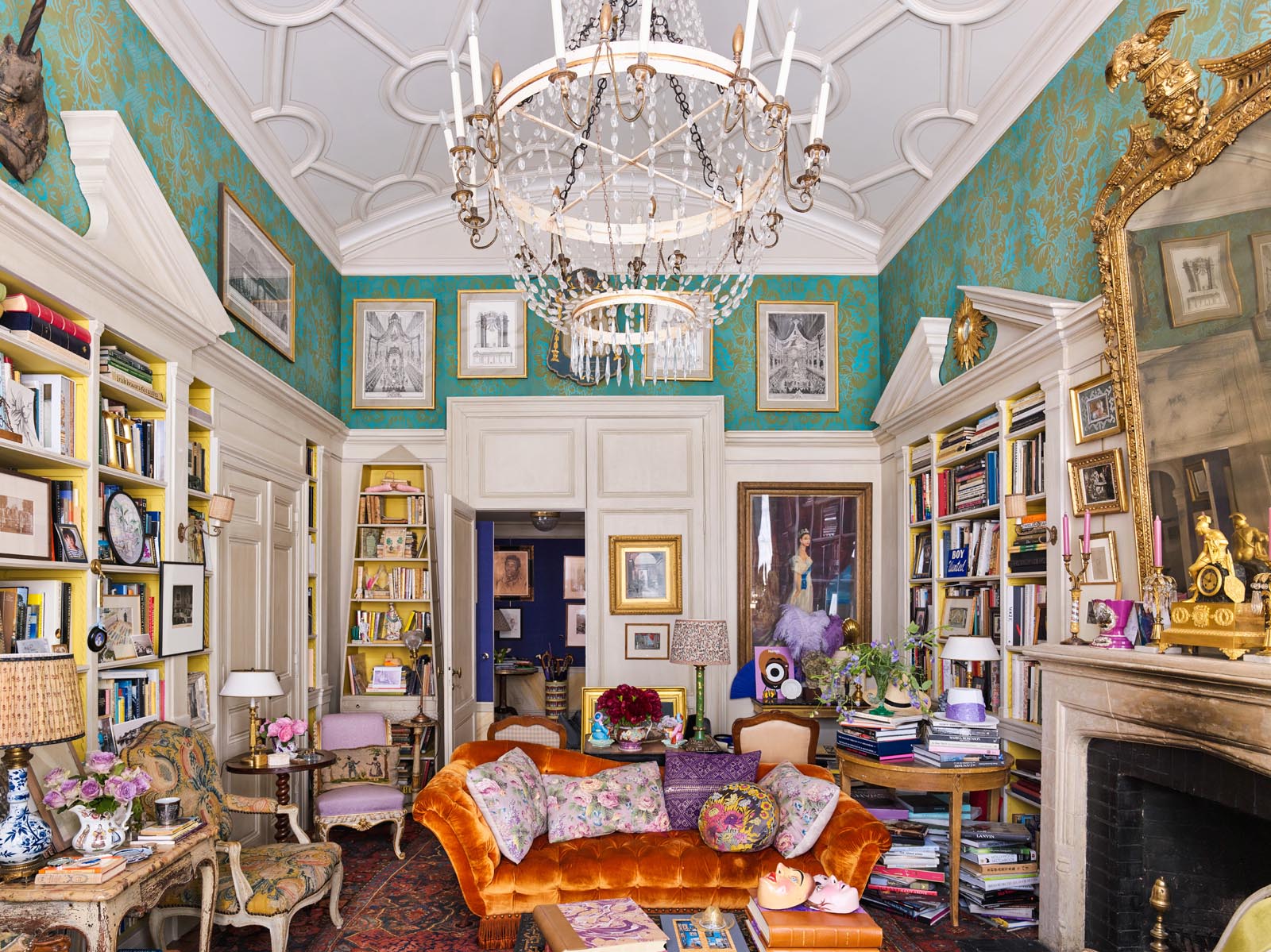
The Récamier sofa in the center of the library drawing room came from a scheme by the American decorator Sister Parish. Studio Peregalli covered it in custom-dyed marmalade silk velvet. On the left are a marble-top Louis XV table, a white-painted needlepoint Louis XV bergère chair and a 1850s gesso slipper chair upholstered in lilac watered silk. The 1961 portrait of the Queen is by Alfred Kingsley Lawrence, and the obelisk bookcase is an early David Hicks design – its coloring exactly matched the scheme chosen for the library. The mid-18th-century etchings hanging on the frieze above the panelling are by Charles Nicholas Cochin.
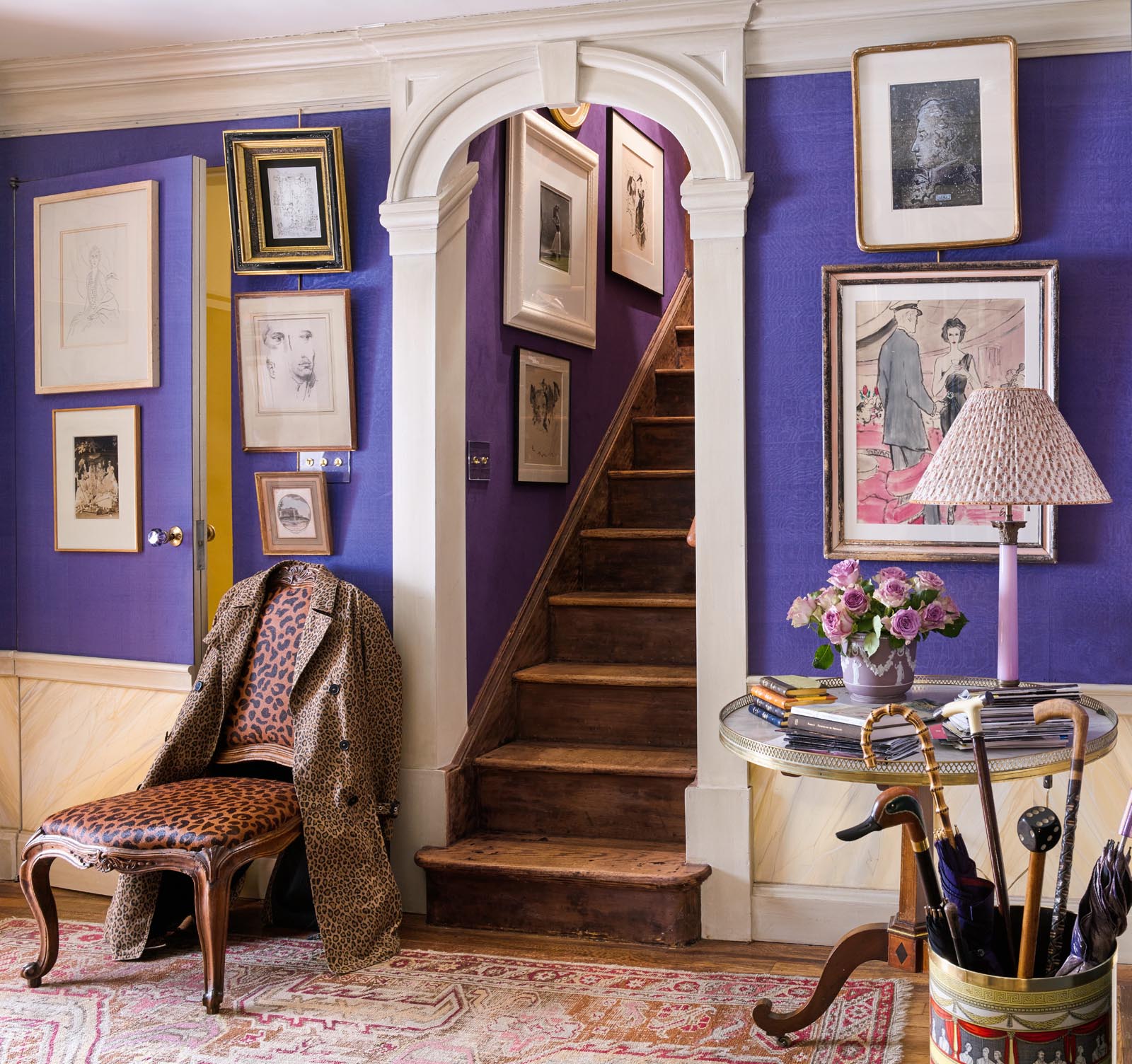
In the entrance hall the walls are hung with cotton moiré found at Alef in Cairo. The Louis XV side chair was upholstered in leopard-stamped pony skin by designer Albert Hadley, and the leopard trench coat is by Saint Laurent. On the Charles X table the lilac column lamp is crowned with a lampshade made by Studio Peregalli of antique sari fabric. Behind it is a late 1940s fashion study by Carl Erickson (Eric), and above hangs a portrait of Mozart by Eugene Berman. Above the chair is a sketch by Glyn Philpot and on the kitchen’s jib door is a Cecil Beaton drawing of Queen Ena of Spain.
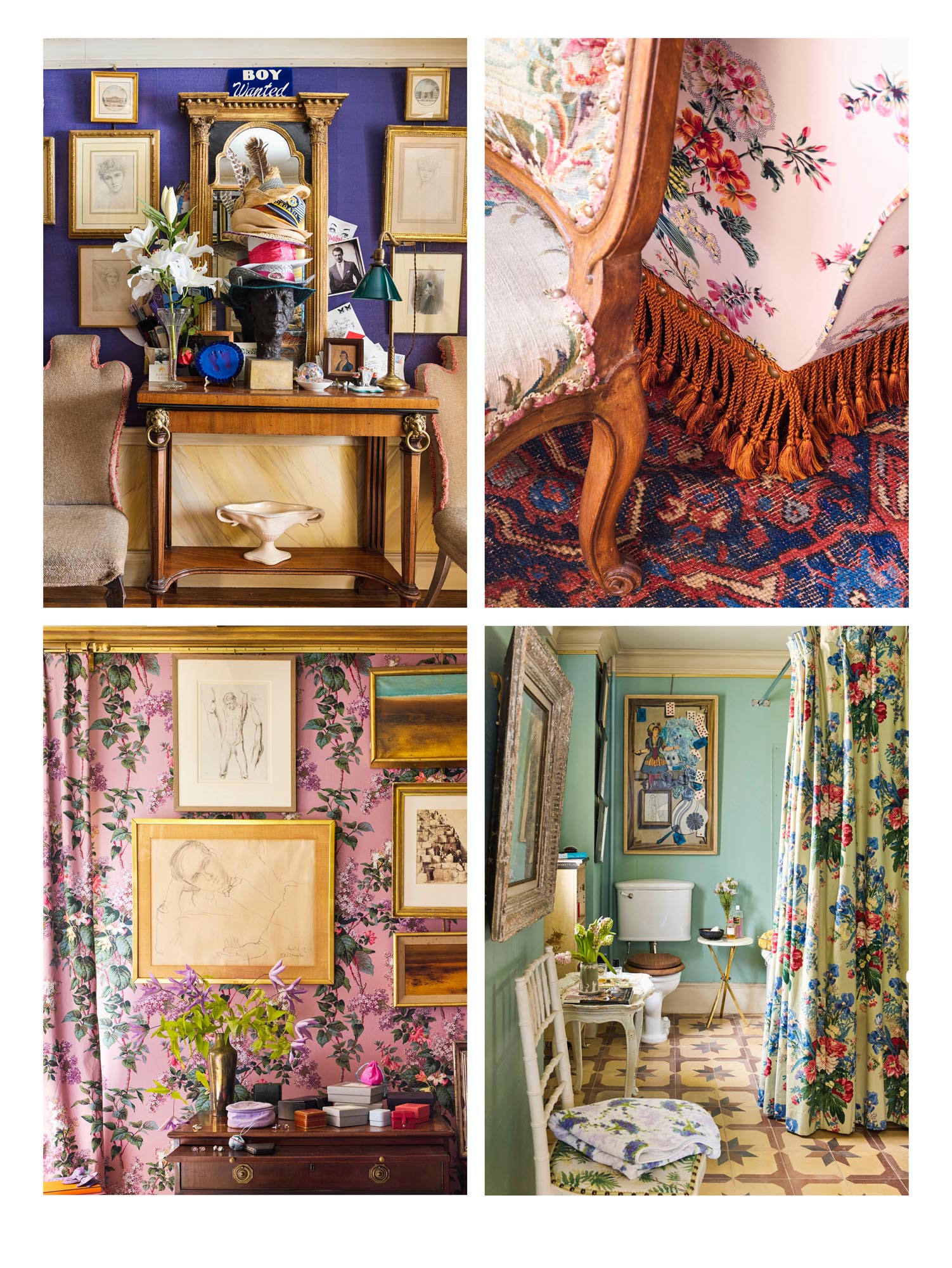
CLOCKWISE FROM TOP LEFT On the William IV console table is a 1930s Constance Spry vase and a bust of Noel Coward by his stage designer, artist Gladys Calthrop; the Regency pier glass is flanked by a self-portrait by Violet, Duchess of Rutland and her portrait of her daughter, Lady Diana Cooper. Aubusson tapestry upholstery on a Louis XV side chair and on the drawing room sofa Le Manach’s Palmyre fabric, finished with silk fringe custom-made and dyed by Studio Peregalli. 19th-century encaustic floor tiles from Valencia, and Lee Jofa’s hand-blocked Kingston Lacy chintz shower curtain in the main bathroom; the trompe l’œil painting above the lavatory is by Martin Battersby. In the bedroom, a portrait of Truman Capote by René Bouché, used for the dust jacket of the paperback edition of Breakfast at Tiffany’s, hangs below an Augustus John nude.
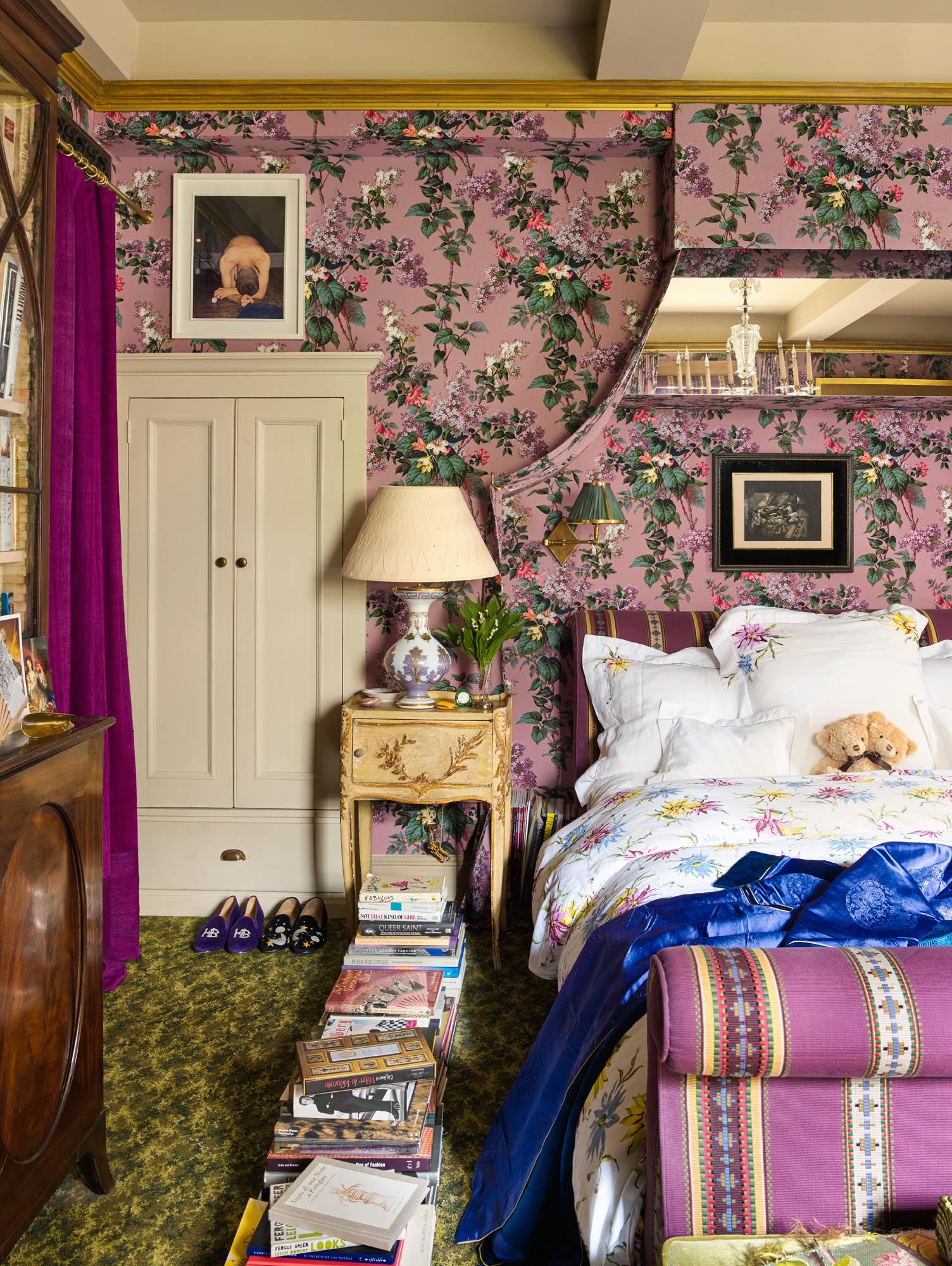
The walls of the master bedroom are covered in an 1880s lilac document cretonne by Scalamandre, and the Syrie Maugham sleigh bed is upholstered in a Madeleine Castaing stripe. On the gesso Italian side table is a Napoleon III porcelain lamp with a lampshade by Parish-Hadley. The picture above the bed is by Lila de Nobili, and above the shirt cupboard is a Wolfgang Tillmans photograph. A low wall of books marches across the moss design carpet custom-made by Colefax & Fowler.
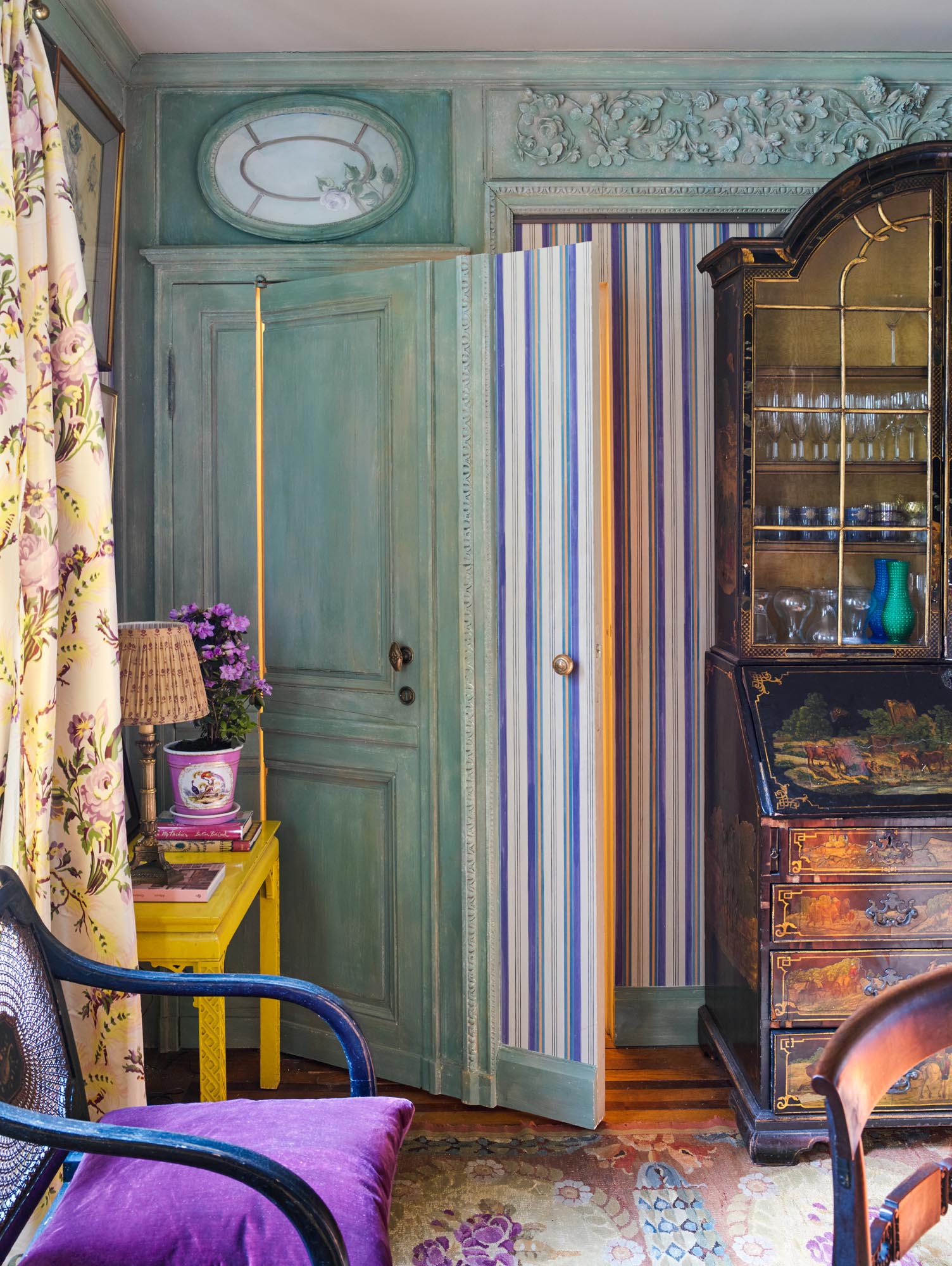
In the dining room, Studio Peregalli devised a neoclassical scheme to disguise mismatched beams and step-backs and subsequently found a Louis XVI boiserie alcove panel that matched their design. It was cut down to size (the œil de bœuf windows turning on their sides in the process) and stripped to reveal its original eighteenth-century green paint. The local planning authority insisted on a door wide enough for a wheelchair, so Studio Peregalli came up with the ingenious solution of cutting a piece out of the wall so that the door and part of the wall swing open together.